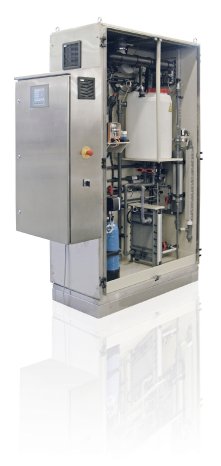The electrolysis system Dulco®Lyse generate ultra-pure hypochlorous acid in a vacuum process. A saturated solution of sodium chloride is produced in a salt dissolving tank, included in the scope of delivery for this purpose, which is then electrolysed in a diaphragm cell. The hypochlorous acids (ECA water) are increasingly used in the food industry and drinks industry as a disinfectant.
In this process chloride-free sodium lye and hydrogen are produced in the cathode area; high-purity chlorine gas and diluted residual brine are produced in the anode area. The areas are separated from one another by a diaphragm.
The chlorine gas produced is immediately separated from the residual brine and dissolved as hypochlorous acid. The sodium lye is temporarily stored and added to hypochlorous acid using a metering pump. The result is a neutral, extremely low-chloride disinfection solution, temporarily stored in the product tank until metered through separate metering stations.
Even under changing conditions, the highly effective solution delivers consistent quality with a constant FAC (Free Available Chlorine) content of 400 ppm. The extremely low chloride content is significantly below the level of comparable processes in which more than 20 times as much chloride is often produced. The surfaces of pipes, machine parts and equipment are not attacked by the minimal chloride concentration; corrosion is reliably avoided.
In contrast to conventional processes which often convert around just 5% of the sodium chloride, Smart Disinfection, developed by the Heidelberg-based manufacturer, converts around 85%.
The operating costs are reduced considerably due to the lower consumption of energy and salt and the fact that no preservatives are used in beverage manufacturing processes.


